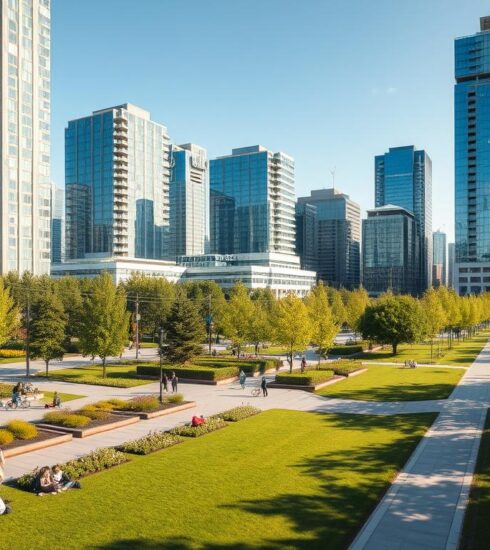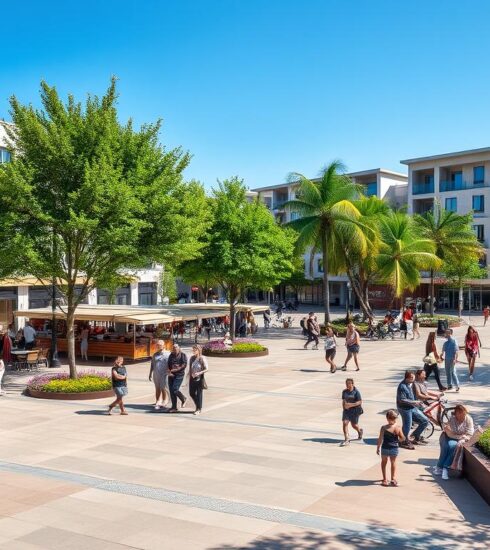From High-Rises to Hidden Trails: Exploring Vancouver’s Multifaceted Urban Design
- Jackie De Burca
- November 20, 2024
Vancouver, a city renowned for its stunning natural landscapes and progressive urban planning, is a veritable tapestry of architectural marvels and sustainable design. As one navigates through its streets, the skyline is punctuated by towering glass-and-steel skyscrapers, while hidden amongst the urban fabric lie tranquil greenways and trails that seamlessly blend the built environment with the great outdoors1.
This dynamic interplay between modernity and nature is a hallmark of Vancouver’s urban design, which has earned the city accolades for its livability, sustainability, and inclusive development policies. Driven by a civic culture that values local democratic processes and community engagement, Vancouver’s urban landscape showcases a remarkable balance between the high-density cityscape and the verdant natural oases that permeate its neighbourhoods1.
Key Takeaways
- Vancouver’s urban design is characterised by a unique blend of modern architecture and natural landscapes.
- The city exemplifies inclusive development policies, high transit ridership, and sustainable strategies.
- Vancouver’s civic culture is driven by strong popular control, local democratic values, and participatory processes.
- The city’s regime is open yet stable, socially progressive yet fiscally conservative and pro-development, fostering an activist, tolerant, and entrepreneurial civic culture.
- Vancouver’s urban design is a testament to the successful integration of high-density development and natural green spaces.
Overview of Vancouver's Urban Landscape
Vancouver’s urban landscape is renowned for its unique “Vancouver Model” of development, which emphasises tall, slender high-rise towers set atop townhouse podiums2. This distinctive architectural approach, combined with a strong focus on view and nature protection, as well as human-scale design, has shaped the city’s built environment in a distinctive way2.
The Intersection of Nature and Urbanity
The integration of nature into Vancouver’s urban fabric is a hallmark of the city’s design philosophy. Expansive green spaces, such as Stanley Park, and a network of greenways and trails, allow residents and visitors alike to connect with the natural environment, even in the heart of the bustling city centre3. This emphasis on preserving and enhancing the city’s natural assets is a key aspect of the “Vancouver Model” and a testament to the city’s commitment to sustainability and livability.
Historical Context of Vancouver's Development
The evolution of Vancouver’s urban landscape is deeply rooted in its history. Once a predominantly industrial economy, the city has undergone a significant transformation, shifting towards a more diverse, service-oriented economy2. This transition, coupled with substantial population growth and densification in the downtown core since the late 1980s, has shaped the city’s built environment and continues to influence its ongoing urban development.
The redevelopment of the False Creek area, exemplified by the Concord Pacific Place project, is a prime example of Vancouver’s urban transformation2. This large-scale, mixed-use development has revitalised a previously polluted industrial area, transforming it into a high-priced residential and recreational hub2. The city’s ability to adapt and reinvent itself is a testament to its resilience and the foresight of its urban planners and policymakers.
As Vancouver continues to evolve, the integration of nature, the preservation of heritage, and the promotion of sustainable practices remain at the forefront of its urban design priorities4. The city’s commitment to creating a livable, vibrant, and environmentally conscious urban landscape sets it apart as a model for other cities aspiring to balance growth with sustainability and quality of life.

Key Features of Urban Design in Vancouver
Vancouver’s urban design landscape is a captivating blend of architectural styles, from the towering high-rises that dot the skyline to the meticulously preserved heritage buildings that pay homage to the city’s past5. This diversity in the built environment reflects Vancouver’s commitment to balancing modern development with the preservation of its rich history and cultural identity.
Architectural Diversity: High-Rises to Heritage Buildings
Vancouver’s architecture is a testament to the city’s embrace of both contemporary and traditional design elements. The city’s iconic high-rise towers, known for their sleek and slender profiles, stand in contrast to the charming heritage structures that line the streets5. This architectural juxtaposition creates a dynamic urban landscape that captivates both residents and visitors alike.
Sustainable Practices in Urban Design
Sustainability is a core principle that underpins Vancouver’s approach to urban design. The city has implemented a range of eco-friendly strategies, including the integration of green infrastructure, the promotion of mixed-use developments, and the prioritisation of active transportation modes6. These sustainable practices not only contribute to the city’s environmental preservation but also enhance the overall quality of life for its inhabitants.
Vancouver’s urban design philosophy is a testament to the city’s commitment to balancing modern progress with the preservation of its heritage5. By embracing both architectural diversity and sustainable practices, Vancouver has established itself as a model for sustainable urban development, leading the way in creating a livable, vibrant, and environmentally-conscious city.
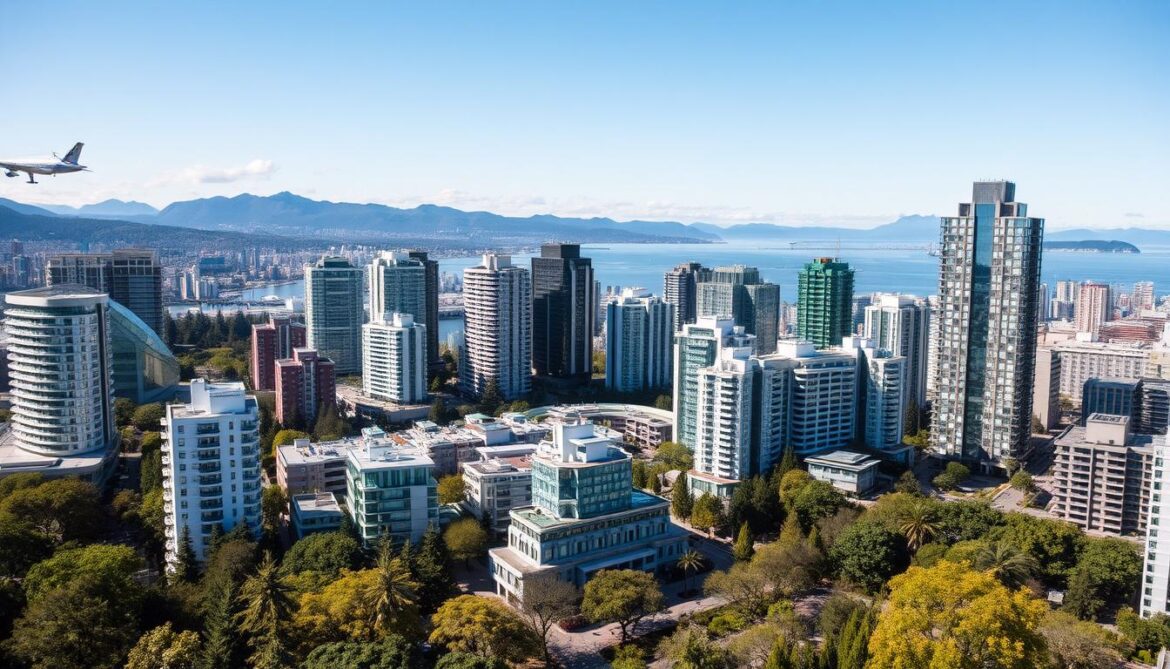
| Key Sustainable Urban Design Practices | Benefits |
|---|---|
| Green infrastructure | Improved air quality, reduced stormwater runoff, and increased access to green spaces6 |
| Mixed-use developments | Reduced reliance on private vehicles, enhanced community connectivity, and support for local businesses6 |
| Active transportation modes | Promotion of physical activity, reduction in greenhouse gas emissions, and improved overall health outcomes6 |
“Vancouver is a global city with inclusive development policy, high transit ridership, and sustainable strategies.”5
The Role of Public Spaces in Urban Design
Vancouver’s urban design is significantly shaped by its network of public spaces, including parks, greenways, and privately owned public spaces (POPS). These spaces play a vital role in connecting communities and fostering a vibrant cultural landscape within the city7.
Parks and Greenways: Connecting Communities
Vancouver’s downtown core has more than doubled its population since the late 1980s, yet the area is characterised by small and fragmented public spaces, many of which are hostile to public use7. The city’s corporate plazas, often the result of an informal approach, date back to the 1970s and 1980s, with 24 out of 31 plazas in the central business district being privately owned7. However, the rationale for these POPS is that they benefit the public by offering accessible spaces in exchange for increased building density7.
Cultural Significance of Public Art Installations
Public art installations are an essential feature of Vancouver’s public spaces, contributing to the cultural landscape of the city. These installations, often secured through incentive zoning practices, provide visually engaging elements that enrich the urban environment7. The creation of POPS in Vancouver is tied to Community Benefit Agreements and Community Amenity Contributions, which aim to ensure that public amenities are integrated into the city’s development7.
The importance of public spaces in Vancouver’s urban design is further underscored by the city’s recent efforts to address gaps in the public space network. In 2017, the Council directed staff to prepare a Downtown Public Space Strategy, which aims to guide the positive transformation of the public realm in the downtown area8. This strategy, combined with various existing public space policies and guidelines, as well as Council motions supporting public space initiatives, demonstrates the city’s commitment to enhancing the role of public spaces in its urban design8.
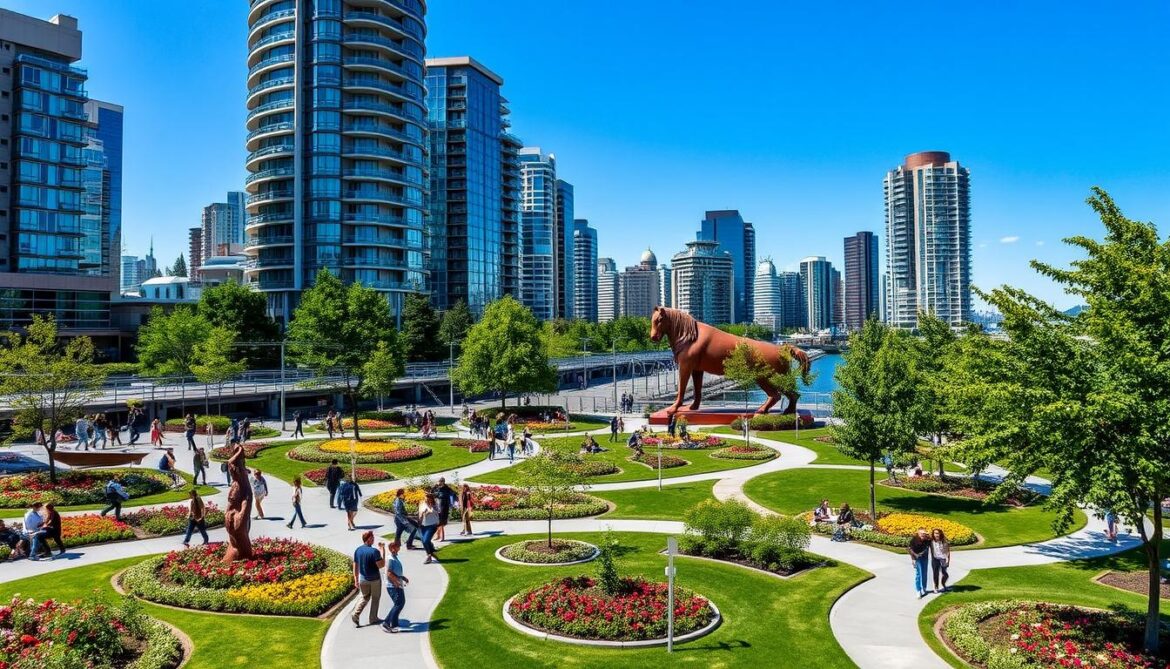
“The Downtown Public Space Strategy will guide the positive transformation of the public realm in Downtown Vancouver.”8
Transportation and Mobility: A Design Perspective
Vancouver’s urban design prioritises sustainable transportation solutions to address the city’s transportation challenges9. With transportation being the largest single source of greenhouse gas emissions in the Metro Vancouver region9, the city has invested heavily in cycling infrastructure and public transit innovations to promote active transport and reduce car dependency9.
Cycling Infrastructure: Promoting Active Transport
The City of Vancouver has made significant strides in developing a comprehensive cycling network to encourage more residents to choose cycling as a mode of transportation10. Over 60 people attended four workshops related to active transportation promotion and enabling10, underscoring the city’s commitment to engaging the community in this effort10. Pilot projects, such as the Active School Travel (Elementary School) and Cycling Promotional Events10, have also been implemented to increase awareness and participation in active transport.
Innovations in Public Transit Solutions
In addition to cycling infrastructure, Vancouver has also focused on innovations in public transit to provide residents with efficient and accessible transportation options9. Despite sustainable transportation investments, single-occupant, conventionally fuelled vehicles still dominate in the transportation sector in Vancouver9, highlighting the need for continued efforts to encourage the use of public transit9. The city’s goal of having two-thirds of trips carried out by active transportation and transit by 20309 demonstrates its commitment to transforming the transportation landscape and reducing the environmental impact of urban mobility.
Integrating transportation design with the overall urban planning strategy is crucial in Vancouver’s efforts to create a more sustainable and livable city9. The challenge of transformative change in the transportation sector involves shifting systems, behaviours, worldviews, and cultures9, which requires a comprehensive approach to address the barriers to low-carbon urban mobility9.
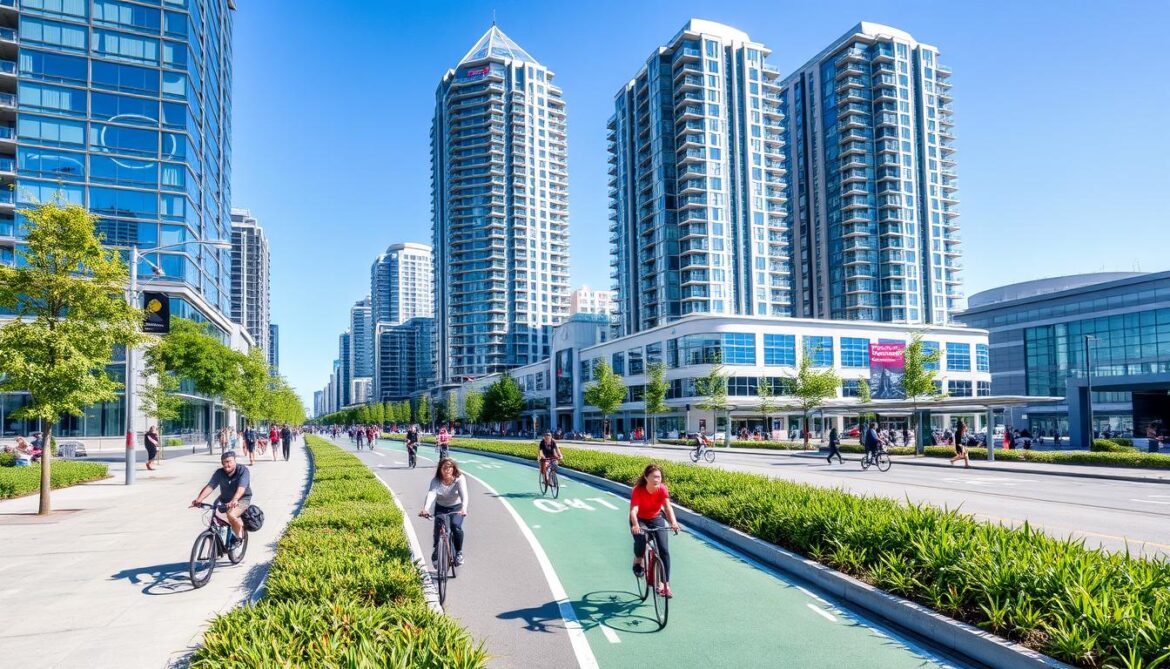
“Transitioning towards greater sustainability in transportation involves a challenge of transformative change, requiring shifts in systems, behaviours, worldviews, and cultures.”
Community Engagement in Urban Development
Community engagement is a cornerstone of Vancouver’s urban development process. The city employs a systematic ongoing process of open consultation and evaluation managed by various local, municipal, and regional governments11. This results in continual negotiation and renegotiation of local policies, ensuring the diverse needs of the community are met.
The Importance of Stakeholder Consultations
Vancouver recognises the vital role of stakeholder consultations in urban planning. By actively involving residents, businesses, and community organisations, the city can better understand the concerns and priorities of its diverse population11. This collaborative approach helps to shape urban design decisions that reflect the unique character and requirements of the Vancouver community.
Successful Case Studies of Community-Led Projects
Vancouver’s commitment to community engagement has led to numerous successful case studies of community-led urban design projects. For instance, the Chattahoochee RiverLands project in Atlanta has seen more than $250 million allocated to upcoming initiatives, demonstrating the transformative impact of community-driven initiatives12. Similarly, the Nashville Yards development in Tennessee aims to be a benchmark for urban revitalisation, celebrating the city’s musical heritage through a participatory design process12.
In Lexington, Kentucky, the Rain Gardens at 900 Block received the 2023 American Society of Landscape Architects Professional Award of Excellence for Residential Design, recognising its success in sustainable stormwater management and enhancing community liveability12. These examples demonstrate the power of community engagement in shaping vibrant and resilient urban environments.

“Walkable neighbourhoods are growing more than twice as fast as the overall market, and streetscape enhancements are associated with higher rents and the attraction of new businesses, adding value to an area13. Walkable communities also offer benefits such as reduced obesity rates, enhanced physical activity, and a stronger sense of community13.”
By embracing a participatory approach to urban design, Vancouver continues to set a standard for community-driven urban development, ensuring its citizens have a voice in shaping the future of their city.
The Impact of Technology on Urban Design
As Vancouver continues to evolve as a vibrant metropolis, technology has emerged as a driving force in shaping the city’s urban design. From smart city solutions to the integration of digital platforms in urban planning, the impact of technology is transforming the way Vancouver approaches the development of its built environment14.
Smart City Solutions in Vancouver
Vancouver’s commitment to sustainability and innovation has led the city to explore a range of smart city solutions. By leveraging advanced technologies, such as big data and artificial intelligence, urban planners and designers are able to address pressing challenges more effectively14. The integration of these technologies has enabled improved disaster response, enhanced environmental monitoring, and better-informed decision-making processes14.
Integrating Digital Platforms for Urban Planning
Vancouver’s urban planning efforts have also benefited from the integration of digital platforms. These platforms facilitate community engagement, allowing residents to provide valuable input and feedback on proposed projects15. Furthermore, the use of data-driven analysis tools has empowered urban designers to make more informed decisions, ensuring that the city’s development aligns with the needs and aspirations of its diverse population14.
| Key Features of Vancouver’s Technology-Driven Urban Design | Description |
|---|---|
| Smart City Solutions | Leveraging big data, AI, and other advanced technologies to address urban challenges, such as disaster response, environmental monitoring, and data-driven decision-making. |
| Digital Platforms for Urban Planning | Integrating community engagement tools and data analysis to enhance the urban planning process and align development with the needs of residents. |
| Sustainable Design Practices | Incorporating eco-friendly building techniques, renewable energy solutions, and green infrastructure to promote environmental sustainability. |
By embracing technological advancements, Vancouver is positioning itself as a model of smart city development, where the integration of digital solutions and community involvement is shaping the future of urban design14. These innovative approaches are crucial in ensuring that the city’s urban landscape continues to evolve in a way that enhances the quality of life for its residents and supports the city’s long-term sustainability goals15.
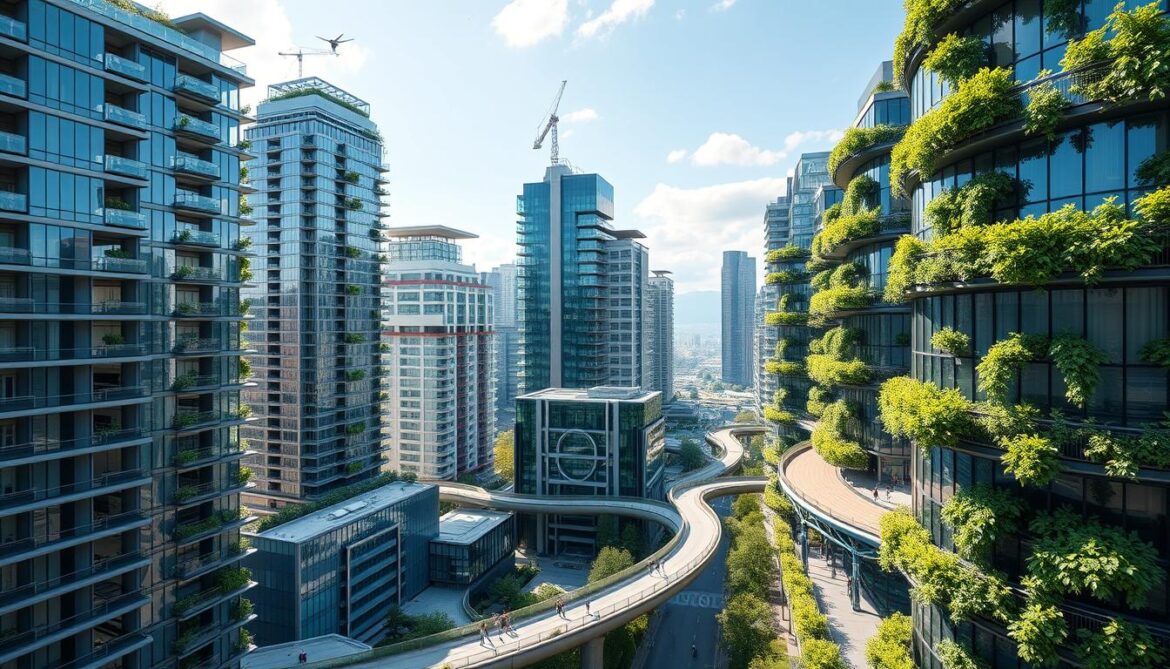
The Future of Vancouver's Urban Design
As Vancouver looks to the future, the city’s urban design is focused on creating a more resilient and sustainable Vancouver urban future. Key trends shaping the next decade include increased densification, climate change adaptation, and the integration of nature-based solutions16. The Urban Studies Major, a first-of-its-kind program in British Columbia, has emerged in response to the rising demand for urban studies, building on the success of the existing Minor in Urban Studies at the University of British Columbia (UBC)16. The program offers five distinct areas of specialization, including Indigenous Urban Futures, Nature of Cities, Globalizing Cities, Technology and Cities, and Cities and Communities, providing students with a comprehensive understanding of the multifaceted challenges and opportunities facing urban centres.
Trends Shaping the Next Decade
As urban development trends continue to evolve, the City of Vancouver is grappling with challenges such as housing affordability and social inclusion. The integration of nature-based solutions, like the new proposal for the Vancouver Art Gallery, is one way the city is working to resilient city design17. The low-profile building features a continuous and permeable street front, aimed at densifying and activating the public realm, while the tall building is designed to express its inner life and respond to the local climate with generous setbacks and overhangs, creating covered and open terrace spaces on various levels17.
The Importance of Resilience in Urban Development
Resilience is becoming increasingly critical as Vancouver prepares for future environmental and social challenges16. The Urban Studies Major’s practical experience through community-engaged capstone projects and co-op placements ensures students are equipped to address these complex issues16. Additionally, the program’s long-term goals include setting up an external advisory board to respond to changing conditions, reflecting the city’s commitment to adaptability and responsiveness.
By embracing resilient city design and addressing emerging urban development trends, Vancouver is positioning itself to meet the evolving needs of its residents and maintain its reputation as a vibrant, livable city. The future of Vancouver’s urban design is one of innovation, sustainability, and a deep respect for the natural environment that has long defined the city’s unique character1617.
Alexandra Steed: Pioneering Urban Masterplanning
As the urban landscape of Vancouver continues to evolve, the city is set to welcome a new player in the realm of innovative urban design. Alexandra Steed, a renowned masterplanner, is slated to open a Vancouver office in 202418, signaling the growing importance of sustainable and liveable city planning in the region.
Opening a Vancouver Office in 2024
Alexandra Steed Urban, a firm with a global reputation for its expertise in masterplanning and urban design, is poised to make a significant impact on Vancouver’s urban fabric. The decision to establish a local presence in the city underscores the firm’s commitment to shaping the future of Vancouver’s built environment18.
Vision and Services Offered
With a focus on creating sustainable, accessible, and community-driven cities, Alexandra Steed Urban brings a wealth of experience to the table. The firm’s suite of services includes masterplanning, urban design, and a range of integrated solutions aimed at enhancing the liveability and resilience of urban areas18.
As Vancouver continues to grapple with the challenges of rapid growth and evolving societal needs, Alexandra Steed Urban’s expertise is expected to contribute significantly to the city’s ongoing transformation18. With a proven track record of delivering innovative and impactful urban design projects around the world, the firm’s arrival in Vancouver is a promising development for the city’s urban planning landscape.
“We are thrilled to be establishing a presence in Vancouver, a city that is at the forefront of sustainable urban development. Our team looks forward to collaborating with local stakeholders to create vibrant, liveable, and resilient communities that enhance the overall quality of life for residents.”
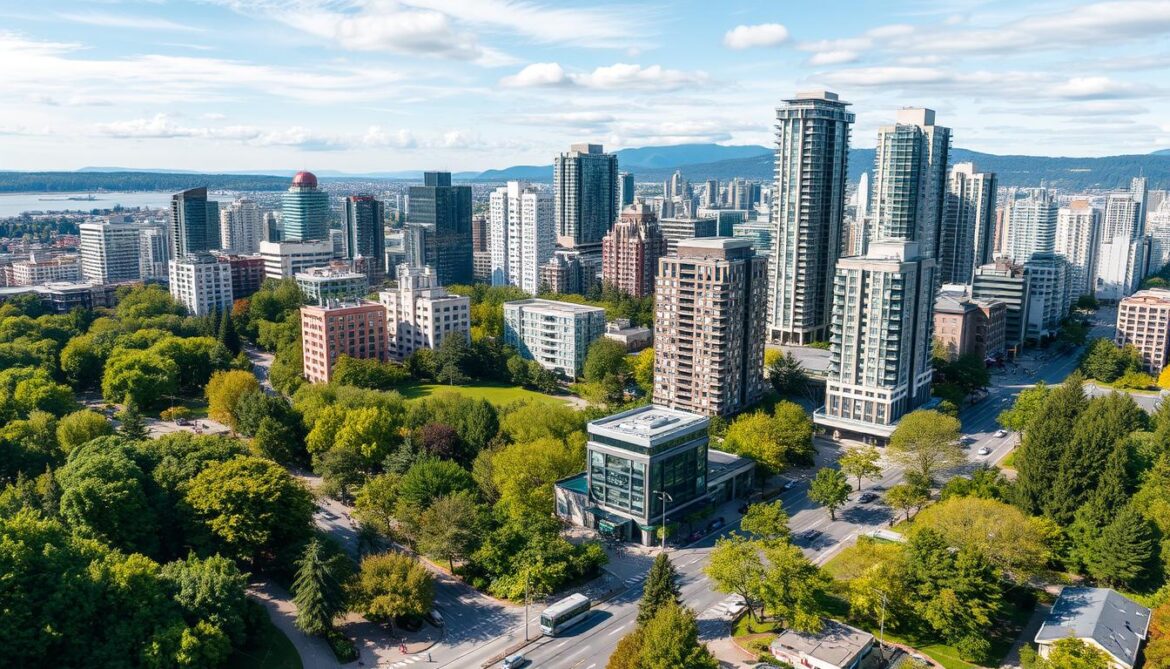
Conclusion: Embracing Vancouver's Unique Urban Fabric
Vancouver’s multifaceted urban design plays a crucial role in shaping the quality of life for its residents. The city’s unique approach to urban planning, balancing natural beauty with modern development, has created a distinctive urban fabric that sets it apart from many other metropolitan areas19. From the integration of biodiversity-friendly practices to the establishment of expansive green spaces and efficient public transportation, Vancouver has positioned itself as a global leader in sustainable urbanism20.
Reflection on Urban Design's Role in Quality of Life
As Vancouver continues to evolve, the importance of urban design in enhancing the city’s livability becomes increasingly evident19. The strategic incorporation of features like rain gardens, bioswales, and permeable pavements showcases a symbiotic relationship between urban living and nature, improving air quality, regulating climate, and mitigating the urban heat island effect19. This holistic approach to urban design has significantly contributed to the high quality of life enjoyed by Vancouver’s residents, positioning the city as a benchmark for sustainable and liveable urban environments.
Encouraging Further Exploration of Vancouver's Urban Design
Looking ahead, there are numerous opportunities for further exploration and innovation in Vancouver’s urban design21. As the city continues to lead in areas such as climate change planning, healthy communities planning, and sustainable mobility, it serves as an inspiring example for other cities striving to achieve a more harmonious balance between the built and natural environments20. By continuing to prioritise ecosystem protection, renewable energy, and inclusive urban development, Vancouver can pave the way for a future where urban design seamlessly integrates with the natural world, enhancing the overall well-being of its residents and the planet.
FAQ
What are the key features of Vancouver’s urban design?
How does Vancouver’s approach to public spaces contribute to its urban design?
What are the key sustainable transportation solutions integrated into Vancouver’s urban design?
How does community engagement shape Vancouver’s urban development process?
What role does technology play in shaping the future of Vancouver’s urban design?
How is the opening of a Vancouver office by renowned urban masterplanner Alexandra Steed significant for the city’s urban design?
Source Links
- Micromobility in Urban Trail Paths: Expanding and Strengthening the Planning of 15-Minute Cities – https://www.mdpi.com/2073-445X/12/12/2181
- Microsoft Word – LowryMcCann AsianintheMix Submissiondraft _Feb10-1.docx – https://www.sfu.ca/~emccann/LowryMcCann AsianintheMix.pdf
- Vancouver’s Urban Oasis: A Walking Tour – https://powertraveller.com/vancouvers-urban-oasis-a-walking-tour/?srsltid=AfmBOorXvew9JTuQ0ArMVeI7GXIjPAht00VXzwpJF_dT1SqhLvQFVXWX
- Growing Space: The Potential for Urban Agriculture in the City of Vancouver – https://www.slideshare.net/slideshow/xwc52/39049808
- The Origins of Vancouverism: A Historical Inquiry into the Architecture and Urban form of Vancouver, British Columbia – https://www.academia.edu/85398752/The_Origins_of_Vancouverism_A_Historical_Inquiry_into_the_Architecture_and_Urban_form_of_Vancouver_British_Columbia
- Sustainable Urban Planning: A Comprehensive Guide – https://holistiquetraining.com/en/news/sustainable-urban-planning-a-comprehensive-guide
- PDF – https://www.vancouverseniorsadvisory.ca/wp-content/uploads/Accessing_Vancouvers_privately-owned_public_spaces_Rahi_2012.pdf
- Report – Places for People: Downtown Public Space Strategy: 2020 Jun 9 – https://council.vancouver.ca/20200609/documents/p1.pdf
- Climate action in urban mobility: personal and political transformations | Buildings & Cities – https://journal-buildingscities.org/articles/10.5334/bc.249
- Active Transportation Promotion and Enabling plan – https://vancouver.ca/files/cov/active-transportation-promotion-and-enabling-full-plan.pdf
- BA_4548698_AM_Seine – https://campus-fryslan.studenttheses.ub.rug.nl/455/1/BA4548698AMSeine.pdf
- Prioritizing Multidisciplinary Collaboration to Build Resilient Urban Environments – https://urbanland.uli.org/resilience-and-sustainability/prioritizing-multidisciplinary-collaboration-to-build-resilient-urban-environments
- The Walkable City: How Urban Design Enhances Community and Connectivity – https://constructive-voices.com/the-walkable-city-how-urban-design-enhances-community-and-connectivity/
- Advancing Urban Life: A Systematic Review of Emerging Technologies and Artificial Intelligence in Urban Design and Planning – https://www.mdpi.com/2075-5309/14/3/835
- PDF – https://www.fepbl.com/index.php/estj/article/view/955/1170
- Shaping tomorrow’s cities: SCARP and Geography introduce an innovative Major in Urban Studies – News | UBC Applied Science – https://apsc.ubc.ca/news/2023/shaping-tomorrows-cities-scarp-and-geography-introduce-innovative-major-in-urban-studies
- 438 Vancouver Art Gallery – Herzog & de Meuron – https://www.herzogdemeuron.com/projects/438-vancouver-art-gallery/
- Book of Abstracts_20220824.indd – https://adk.elsevierpure.com/files/69412456/Book_of_Abstracts_20220824rd.pdf
- How Biodiversity is Transforming Urban Architecture – https://www.anytopic.io/podcast/48e51cba-802a-429b-a2e0-fc82b1b48f6a
- 2024 Urban Development Strategies: Shaping Cities for Tomorrow » Archova Visuals – https://archovavisuals.com/urban-development-strategies/
- Awards for Planning Excellence – Canadian Institute of Planners (CIP) – https://www.cip-icu.ca/awards-for-planning-excellence/







